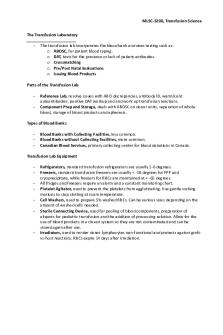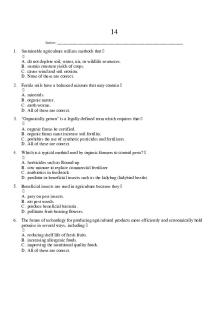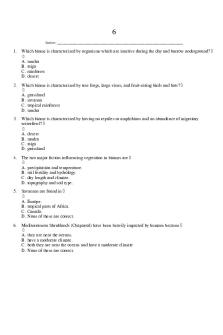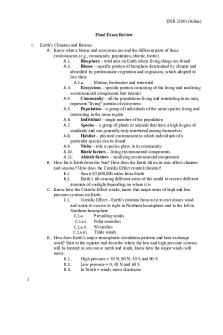14 - An intro to environmental science course PDF

| Title | 14 - An intro to environmental science course |
|---|---|
| Course | Environmental Science |
| Institution | American University of Sharjah |
| Pages | 34 |
| File Size | 292.7 KB |
| File Type | |
| Total Downloads | 95 |
| Total Views | 173 |
Summary
An intro to environmental science course...
Description
14 Student: ___________________________________________________________________________
1.
Sustainable agriculture utilizes methods that A. do not deplete soil, water, air, or wildlife resources. B. sustain constant yields of crops. C. cause wind and soil erosion. D. None of these are correct.
2.
Fertile soils have a balanced mixture that may contain A. minerals. B. organic matter. C. earth worms. D. All of these are correct.
3.
"Organically grown" is a legally defined term which requires that A. organic farms be certified. B. organic farms must increase soil fertility. C. prohibits the use of synthetic pesticides and fertilizers. D. All of these are correct.
4.
Which is a typical method used by organic farmers to control pests? A. herbicides such as Round-up B. cow manure to replace commercial fertilizer C. antibiotics in feedstock D. predator or beneficial insects such as the ladybug (ladybird beetle)
5.
Beneficial insects are used in agriculture because they A. prey on pest insects. B. eat pest weeds. C. produce beneficial bacteria. D. pollinate fruit-bearing flowers.
6.
The future of technology for producing agricultural products more efficiently and economically hold promise in several ways, including A. reducing shelf life of fresh fruits. B. increasing allergenic foods. C. improving the nutritional quality foods. D. All of these are correct.
7.
Genetically modified (GM) foods have been called A. the breakfast of the future. B. brand new processes. C. frankenfoods. D. All of these are correct.
8.
A genetically modified organism has had one or more A. genes altered. B. genes destroyed. C. chromosomes damaged. D. All of these are correct.
9.
Integrated pest management requires A. a complete genetic make-up of pests. B. a complete knowledge of the pest's life history. C. extensive application of pesticides. D. All of these are correct.
10. The Green Revolution refers to A. the introduction of new plant varieties and farming methods during the 1950s and 1960s. B. the use of green manure to increase fertility. C. a political uprising by farmers protesting wheat embargoes. D. None of these are correct. 11. The price and availability of chemical fertilizers is strongly influenced by A. the price of oil on the world market. B. the amount of rain received in any given growing season. C. the price a farmer receives for his crop. D. None of these are correct. 12. If fertilizers are applied just before a heavy rain, A. soils become saturated and there is over-growth in the plants. B. macronutrients leach out and only micronutrients remain in the soil. C. nutrients are carried into streams and lakes and encourage unwanted plant growth. D. All of these are correct. 13. Which of the following is a characteristic of a perfect pesticide? A. a short-life B. affect only target organisms C. would be inexpensive D. All of these are correct.
14. Pesticides that break down quickly in the environment are called A. nontarget pesticides. B. nonpersistent pesticides. C. insecticides. D. persistent pesticides. 15. DDT is an example of a(n) A. insecticide. B. herbicide. C. fungicide. D. rodenticide. 16. DDT is a type of A. organophosphate. B. herbicide. C. chlorinated hydrocarbon. D. carbamate. 17. Organophosphates and carbamates work by A. interfering with an insect's nervous system. B. interrupting photosynthesis in weeds. C. preventing apples from dropping from trees. D. causing internal bleeding in mammals. 18. Biomagnification occurs most commonly in which organisms? A. large fish B. birds of prey C. carnivores D. All of these are correct. E. None of these are correct. 19. Chemicals which are released by female insects to attract male insects are called A. auxins. B. DDT. C. insecticides. D. pheromones. 20. Increased crop yields in the U.S. are the result of A. improved agricultural methods. B. more efficient machinery. C. the application of fertilizers. D. All of these are correct.
21. Slash-and-burn practices contribute primarily to what environmental problem? A. desertification B. deforestation C. El ni–o D. ozone depletion 22. What accounts for the increased productivity of the U.S. over Brazil in small grain production? A. climate B. fertilizer C. labor force D. better seed 23. Which of the following is NOT a reason to add a food additive? A. prolong storage life B. deter insects C. add nutritive value D. make food more attractive 24. Which of the following is NOT a problem associated with pesticides? A. resistance to the pesticide B. bioaccumulation C. increased soil erosion D. persistence in the environment 25. Which of the following is a macronutrient? A. nitrogen B. manganese C. zinc D. boron 26. Pesticide resistance is A. accumulation of pesticides in fatty tissues. B. the death of individuals of a nontarget species. C. pesticide tolerant individuals who survive and reproduce, which makes the pesticide less effective for future pest generations. D. only effective to control rodents. 27. An environmental problem associated with pesticide use in the former Soviet Union is A. an outbreak of plague over large areas of the country. B. improved drinking water quality. C. increase in radioactivity levels in soil and air. D. contamination of baby food with nitrates and pesticides.
28. All of the following are benefits of organic farming and crop rotation as a sustainable agriculture method EXCEPT A. it requires the use of few or no pesticides. B. it typically requires less water. C. it can spread out the risk of crop failure. D. it can best help large-scale farmers. 29. Genetically modified organisms are created by A. inserting chemical pesticides into embryos to improve pest or disease resistance. B. inserting pieces of DNA, which will result in pest or disease resistance in a crop. C. injecting growth hormones into seeds or pregnant animals. D. cloning of good producers to make millions of offspring. 30. People that oppose the use of GMOs argue that A. it is too expensive a method and will cause a drastic increase in food prices. B. farmers would be at risk for pesticide poisoning. C. no long-term studies have been done to ensure safety. D. it will raise the fat content of many everyday foods creating more obesity. 31. Which group of countries has refused to buy genetically modified grains from the United States? A. EU B. OPEC C. IUCN D. NAFTA 32. Advocates of GMOs argue that A. superweeds could develop from introducing herbicide resistance genes. B. this method offers promise for solving world hunger problems by increasing crop production. C. monarch butterfly reproduction could be negatively impacted. D. this method offers promise for solving the world's erosion problems. 33. The Integrated Pest Management System was initiated by _______ to implement sustainable landscape practices on campus. A. Cornell University B. University of Florida C. Seattle University D. University of Arizona 34. Which of the following is NOT an issue that for decades has impeded a long-term global solution to feeding the world's hungry? A. food subsidies and trade barriers B. insufficient worldwide agricultural production capacity C. higher fuel costs D. rising demand Which of the following best matches the description?
35. Nutrient needed in extremely small amounts for plant growth. A. weed B. biocide C. pheromone D. macronutrient E. organophosphate F. rodenticide G. auxin H. chlorinated hydrocarbon I. hard pesticide J. soft pesticide K. persistent pesticide L. micronutrient M. biomagnification N. fungicide O. herbicide P. macronutrients Q. micronutrients 36. Nutrient that is required by plants in relatively large amounts. A. weed B. biocide C. pheromone D. macronutrient E. organophosphate F. rodenticide G. auxin H. chlorinated hydrocarbon I. hard pesticide J. soft pesticide K. persistent pesticide L. micronutrient M. biomagnification N. fungicide O. herbicide P. macronutrients Q. micronutrients
37. Nitrogen, phosphorus, and potassium. A. weed B. biocide C. pheromone D. macronutrient E. organophosphate F. rodenticide G. auxin H. chlorinated hydrocarbon I. hard pesticide J. soft pesticide K. persistent pesticide L. micronutrient M. biomagnification N. fungicide O. herbicide P. macronutrients Q. micronutrients 38. Boron, zinc, and manganese. A. weed B. biocide C. pheromone D. macronutrient E. organophosphate F. rodenticide G. auxin H. chlorinated hydrocarbon I. hard pesticide J. soft pesticide K. persistent pesticide L. micronutrient M. biomagnification N. fungicide O. herbicide P. macronutrients Q. micronutrients
39. An unwanted plant. A. weed B. biocide C. pheromone D. macronutrient E. organophosphate F. rodenticide G. auxin H. chlorinated hydrocarbon I. hard pesticide J. soft pesticide K. persistent pesticide L. micronutrient M. biomagnification N. fungicide O. herbicide P. macronutrients Q. micronutrients 40. Pesticide that remains unchanged for a long period of time. A. weed B. biocide C. pheromone D. macronutrient E. organophosphate F. rodenticide G. auxin H. chlorinated hydrocarbon I. hard pesticide J. soft pesticide K. persistent pesticide L. micronutrient M. biomagnification N. fungicide O. herbicide P. macronutrients Q. micronutrients
41. Pesticide that persists for a long period of time. A. weed B. biocide C. pheromone D. macronutrient E. organophosphate F. rodenticide G. auxin H. chlorinated hydrocarbon I. hard pesticide J. soft pesticide K. persistent pesticide L. micronutrient M. biomagnification N. fungicide O. herbicide P. macronutrients Q. micronutrients 42. Pesticide designed to kill mice, rats, and related organisms. A. weed B. biocide C. pheromone D. macronutrient E. organophosphate F. rodenticide G. auxin H. chlorinated hydrocarbon I. hard pesticide J. soft pesticide K. persistent pesticide L. micronutrient M. biomagnification N. fungicide O. herbicide P. macronutrients Q. micronutrients
43. Pesticide that breaks down into harmless products in a few hours or days. A. weed B. biocide C. pheromone D. macronutrient E. organophosphate F. rodenticide G. auxin H. chlorinated hydrocarbon I. hard pesticide J. soft pesticide K. persistent pesticide L. micronutrient M. biomagnification N. fungicide O. herbicide P. macronutrients Q. micronutrients 44. Pesticide consisting of carbon, hydrogen, and chlorine. A. weed B. biocide C. pheromone D. macronutrient E. organophosphate F. rodenticide G. auxin H. chlorinated hydrocarbon I. hard pesticide J. soft pesticide K. persistent pesticide L. micronutrient M. biomagnification N. fungicide O. herbicide P. macronutrients Q. micronutrients
45. Class of pesticides that interferes with normal nerve impulses. A. weed B. biocide C. pheromone D. macronutrient E. organophosphate F. rodenticide G. auxin H. chlorinated hydrocarbon I. hard pesticide J. soft pesticide K. persistent pesticide L. micronutrient M. biomagnification N. fungicide O. herbicide P. macronutrients Q. micronutrients 46. Class of pesticides that kills fungi. A. weed B. biocide C. pheromone D. macronutrient E. organophosphate F. rodenticide G. auxin H. chlorinated hydrocarbon I. hard pesticide J. soft pesticide K. persistent pesticide L. micronutrient M. biomagnification N. fungicide O. herbicide P. macronutrients Q. micronutrients
47. Kind of chemical that kills many different types of living things. A. weed B. biocide C. pheromone D. macronutrient E. organophosphate F. rodenticide G. auxin H. chlorinated hydrocarbon I. hard pesticide J. soft pesticide K. persistent pesticide L. micronutrient M. biomagnification N. fungicide O. herbicide P. macronutrients Q. micronutrients 48. Pesticide designed to kill plants. A. weed B. biocide C. pheromone D. macronutrient E. organophosphate F. rodenticide G. auxin H. chlorinated hydrocarbon I. hard pesticide J. soft pesticide K. persistent pesticide L. micronutrient M. biomagnification N. fungicide O. herbicide P. macronutrients Q. micronutrients
49. Chemical produced by one animal that changes the behavior of another. A. weed B. biocide C. pheromone D. macronutrient E. organophosphate F. rodenticide G. auxin H. chlorinated hydrocarbon I. hard pesticide J. soft pesticide K. persistent pesticide L. micronutrient M. biomagnification N. fungicide O. herbicide P. macronutrients Q. micronutrients 50. Plant hormone that stimulates growth. A. weed B. biocide C. pheromone D. macronutrient E. organophosphate F. rodenticide G. auxin H. chlorinated hydrocarbon I. hard pesticide J. soft pesticide K. persistent pesticide L. micronutrient M. biomagnification N. fungicide O. herbicide P. macronutrients Q. micronutrients
51. Increases in the amount of material at successively higher trophic levels. A. weed B. biocide C. pheromone D. macronutrient E. organophosphate F. rodenticide G. auxin H. chlorinated hydrocarbon I. hard pesticide J. soft pesticide K. persistent pesticide L. micronutrient M. biomagnification N. fungicide O. herbicide P. macronutrients Q. micronutrients 52. Chemical fertilizers are used in agriculture because they provide greater amounts of nutrients and organic matter than are found in the natural soil. True False 53. In some respects, fertilizer can be used to replace human labor. True False 54. Fertilizers do not alter soil characteristics. True False 55. Most of the world's food supply is grown on small slash-and-burn garden plots. True False 56. Major problems with monoculture include plant disease, pests, and soil depletion. True False 57. Mechanized agriculture has substituted the labor of humans with energy stored in petroleum products. True False 58. A perfect pesticide kills or inhibits the growth of nontarget organisms as well as target organisms. True False 59. The perfect pesticide should have a short half-life. True False
60. Tilling the soil can reduce weeds. True False 61. Currently the cost of pesticides far exceeds the profit from crops produced. True False 62. When vegetation is burned on a site, it releases nutrients that are tied up in the biomass. True False 63. Mechanized agriculture is typical of undeveloped tropical regions. True False 64. Monoculture farming is the best method to use to prevent soil erosion. True False 65. Monoculture utilizes several crops grown over a large area for efficient planting, cultivating, and harvesting. True False 66. Organic farming uses legumes to add nitrogen to the soil. True False 67. All products that are sold as organic must be certified. True False 68. Persistent pesticides decompose quickly and present less of an environmental hazard. True False 69. Persistent pesticides are more toxic than nonpersistent pesticides and must be handled with greater care. True False 70. Biotechnology techniques are used to insert genes from species to another. True False 71. Europe, England, and Canada account for over two-thirds of all biotechnology crops planted globally. True False 72. Genetically modified (GM) foods are also sometimes called "super foods." True False 73. Selective plant breeding is a new concept. True False
74. In the United States, and estimated 60% of processed foods contain GM ingredients. True False 75. "Biotech" crops include soybeans, canola, corn, and cotton. True False 76. Polyculture is a process where different species of plants are grown together in the same place at the same time. True False
14 Key 1.
Sustainable agriculture utilizes methods that A. do not deplete soil, water, air, or wildlife resources. B. sustain constant yields of crops. C. cause wind and soil erosion. D. None of these are correct. Enger - Chapter 14 #1
2.
Fertile soils have a balanced mixture that may contain A. minerals. B. organic matter. C. earth worms. D. All of these are correct. Enger - Chapter 14 #2
3.
"Organically grown" is a legally defined term which requires that A. organic farms be certified. B. organic farms must increase soil fertility. C. prohibits the use of synthetic pesticides and fertilizers. D. All of these are correct. Enger - Chapter 14 #3
4.
Which is a typical method used by organic farmers to control pests? A. herbicides such as Round-up B. cow manure to replace commercial fertilizer C. antibiotics in feedstock D. predator or beneficial insects such as the ladybug (ladybird beetle) Enger - Chapter 14 #4
5.
Beneficial insects are used in agriculture because they A. prey on pest insects. B. eat pest weeds. C. produce beneficial bacteria. D. pollinate fruit-bearing flowers. Enger - Chapter 14 #5
6.
The future of technology for producing agricultural products more efficiently and economically hold promise in several ways, including A. reducing shelf life of fresh fruits. B. increasing allergenic foods. C. improving the nutritional quality foods. D. All of these are correct. Enger - Chapter 14 #6
7.
Genetically modified (GM) foods have been called A. the breakfast of the future. B. brand new processes. C. frankenfoods. D. All of these are correct. Enger - Chapter 14 #7
8.
A genetically modified organism has had one or more A. genes altered. B. genes destroyed. C. chromosomes damaged. D. All of these are correct. Enger - Chapter 14 #8
9.
Integrated pest management requires A. a complete genetic make-up of pests. B. a complete knowledge of the pest's life history. C. extensive application of pesticides. D. All of these are correct. Enger - Chapter 14 #9
10.
The Green Revolution refers to A. the introduction of new plant varieties and farming methods during the 1950s and 1960s. B. the use of green manure to increase fertility. C. a political uprising by farmers protesting wheat embargoes. D. None of these are correct. Enger - Chapter 14 #10
11.
The price and availability of chemical fertilizers is strongly influenced by A. the price of oil on the world market. B. the amount of rain received in any given growing season. C. the price a farmer receives for his crop. D. None of these are correct. Enger - Chapter 14 #11
12.
If fertilizers are applied just before a heavy rain, A. soils become saturated and there is over-growth in the plants. B. macronutrients leach out and only micronutrients remain in the soil. C. nutrients are carried into streams and lakes and encourage unwanted plant growth. D. All of these are correct. Enger - Chapter 14 #12
13.
Which of the following is a characteristic of a perfect pesticide? A. a short-life B. affect only target organisms C. would be inexpensive D. All of these are correct. Enger - Chapter 14 #13
14.
Pesticides that break down quickly in the environment are called A. nontarget pesticides. B. nonpersistent pesticides. C. insecticides. D. persistent pesticides. Enger - Chapter 14 #14
15.
DDT is an example of a(n) A. insecticide. B. herbicide. C. fungicide. D. rodenticide. Enger - Chapter 14 #15
16.
DDT is a type of A. organophosphate. B. herbicide. C. chlorinated hydrocarbon. D. carbamate. Enger - Chapter 14 #16
17.
Organophosphates and carbamates work by A. interfering with an insect's nervous system. B. interrupting photosynthesis in weeds. C. preventing apples from dropping from trees. D. causing internal bleeding in mammals. Enger - Chapter 14 #17
18.
Biomagnification occurs most commonly in which organisms? A. large fish B. birds of prey C. carnivores D. All of these are correct. E...
Similar Free PDFs

Intro to Transfusion Science
- 3 Pages

Environmental Science
- 16 Pages

Intro to Psych Course Notes
- 44 Pages

BIO LAB Intro to Science
- 12 Pages

Environmental Science Module 1
- 4 Pages

Environmental Science and Engineering
- 109 Pages

Environmental Science Midterm Review
- 17 Pages
Popular Institutions
- Tinajero National High School - Annex
- Politeknik Caltex Riau
- Yokohama City University
- SGT University
- University of Al-Qadisiyah
- Divine Word College of Vigan
- Techniek College Rotterdam
- Universidade de Santiago
- Universiti Teknologi MARA Cawangan Johor Kampus Pasir Gudang
- Poltekkes Kemenkes Yogyakarta
- Baguio City National High School
- Colegio san marcos
- preparatoria uno
- Centro de Bachillerato Tecnológico Industrial y de Servicios No. 107
- Dalian Maritime University
- Quang Trung Secondary School
- Colegio Tecnológico en Informática
- Corporación Regional de Educación Superior
- Grupo CEDVA
- Dar Al Uloom University
- Centro de Estudios Preuniversitarios de la Universidad Nacional de Ingeniería
- 上智大学
- Aakash International School, Nuna Majara
- San Felipe Neri Catholic School
- Kang Chiao International School - New Taipei City
- Misamis Occidental National High School
- Institución Educativa Escuela Normal Juan Ladrilleros
- Kolehiyo ng Pantukan
- Batanes State College
- Instituto Continental
- Sekolah Menengah Kejuruan Kesehatan Kaltara (Tarakan)
- Colegio de La Inmaculada Concepcion - Cebu








